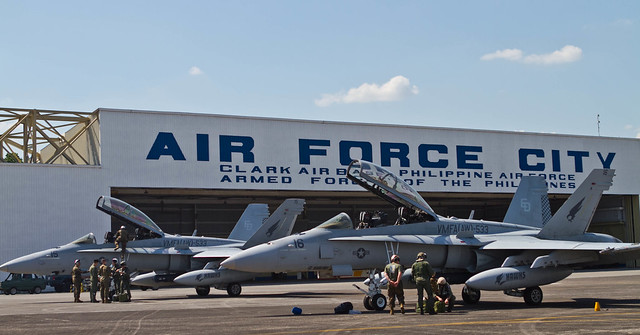The United States of America (US) has send to the Philippines four highly advanced electronic attack jammer E/A-18G Growler jets ahead of the ruling of the Hague-based Permanent Court of Arbitration (PCA) on the South China Sea claim of China filed by the Philippines for breach of its sovereign territory.
The Philippines brought China to court after its 2012 seizure of Scarborough Shoal, which is located within the 200-mile exclusive economic zone of the Philippines. Decision is expected for release on July 12, 2016. Beijing claims nearly all of the South China Sea, setting up conflicts with its neighbors Vietnam, Malaysia, Brunei, Indonesia, and the Philippines.
Four U.S. Navy airborne electronic attack planes complemented by 120 support personnel was sent to Clark Airbase last month in a bid to counter Chinese aerial aggression in the South China Sea. The contingent belongs to the Electronic Attack Squadron (VAQ) 138 which is a land-base expeditionary squadron based at Naval Air Station Whidbey Island, Washington.
The dispatch of electronic warfare planes was made after the U.S. Navy reported difficulties in collecting data in the past months due to employment of Chinese electronic countermeasures. It is expected to support operations of the carrier-based squadrons in the South China Sea.
A typical Electronic Attack Squadron consists of five Boeing EA-18G Growlers. Boeing has argued however that Growler’s effectiveness is enhanced when operating in a three-ship flight versus the single or section operations, thus five plus four, for an effective 3-flight ratios.
China has been seen to declare an Air Defense Identification Zone (ADIZ) in the South China Sea after the July 12 PCA decision and warned the US of 'military confrontation' should it intrude in the South China Sea which it claims it owns.
Tensions are escalating in advance of the decision, with China beginning a naval exercise near the Paracel Islands. Meanwhile, U.S. Navy destroyers Spruance, Momsen and Stethem together with the USS Ronald Reagan Carrier Strike Group are already pre-positioning themselves in the South China sea ahead of the decision.
Meanwhile, the second carrier group John C. Stennis which spent the bulk of its planned seven-month deployment patrolling the South China Sea before leaving June 5 is sailing nearby in the Philippine Sea, while the third carrier is spotted in Japan.

“We won't discuss tactics, specific locations in the South China Sea or future operations anywhere in the region due to operational security,” says Lt. Clint Ramsden, spokesman for U.S. Pacific Fleet.
Last month, these two aircraft carriers conducted naval exercises in the Philippine Sea simulating air defense drills, sea surveillance, and long range strikes.
On Wednesday, the US Navy had seven ships in the region including Reagan, two cruisers, four destroyers, and undisclosed Virginia-class submarine.
The U.S. Navy’s 7th Fleet however downplayed the purpose of EA-18G aircraft deployed in Clark for public consumption saying it was there to train the Philippine Air Force which recently acquired two FA-50 trainer jets from South Korea and help patrol Philippine airspace and sea lanes.
The Boeing EA-18G Growler is a variant of the combat-proven F/A-18F Super Hornet which is the most advanced airborne electronic attack (AEA) platform in the world that provides tactical jamming and electronic protection to U.S. military forces and allies around the world.
The fighter jet purpose is to suppress ground defenses for air strikes, and jams enemy radar while the aircrew eliminates targets on ground or on air. It also has its own arsenal of air-to-air missiles in order to defend itself against attack.

Earlier, five A-10 Thunderbolt ground-attack jets, (better known as the warthog), three H-60G Pavehawk helicopters and one MC-130H Combat Talon special forces infiltration aircraft remained behind at Clark Air Base, along with nearly 300 crew members After a ten-day joint U.S.-Philippine drill that ended in April. In addition, a pair of EP-3E reconnaissance aircraft is also stationed in Clark for routine mission in international airspace over the South China Sea.
According to noted military analysts Andreas Rupprecht, the presence of four EA-18Gs could theoretically limit the operations of the Chinese Air Force (PLAAF) and Navy (PLANAF) in the South China Sea as the Growlers could jam the Chinese radars on the Spratly, Paracel, Pratas and the rest of the islands, including those that have been artificially created, reducing Beijing's ability to establish an ADIZ (Air Defense Identification Zone) in the South China Sea should result of the Hague arbitration be not in its favor.

As to why the A-10 instead of the F-18 attack aircraft which is meant for dogfights with Chinese fighters, Lt. Col. Damien Pickart, a spokesman for US Air Forces Pacific, said that the A-10 has excellent loiter capabilities and maneuverability at low air speeds and altitude than F-16 or F-18 that are “necessary for conducting the air contingent’s air and maritime domain awareness and personnel recovery missions. In essence, it is the most efficient combat aircraft for surveillance and intelligence gathering. Fighter support is however provided by the aircraft carrier should the need arises.













